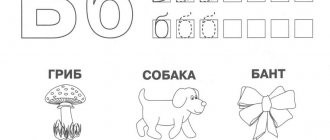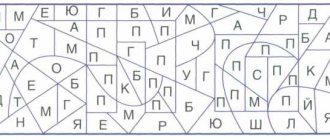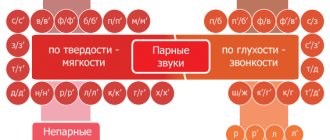Hard and soft consonants
Our train arrived at station No. 1. But here there was a commotion! Consonant sounds were traveling with us on the train. At the station they need to change seats: soft consonants into a bus with soft seats, and hard ones into a bus with hard seats. There are vowel sounds near the buses. Based on them, the consonants should take their places.
But soft and hard consonant sounds forgot which vowels to go to.
Shall we help them? To solve the problem, you need to remember which vowels soften consonants and which ones make them hard.
Consonants are always hard if they are followed by the letters A, O, U, Y, E. For example: cotton wool, bridge, jacket, otter, mayor.
Consonant sounds will be soft if they are followed by the letters E, E, I, Yu, I: forest, dog, kitty, bale, mint. The first consonants in each of these words are pronounced softly [l'], [p'], [m'], [k'], [t'].
Now look at the picture and make the right choice.
Correct answer:
- The vowels E, E, I, Yu, I soften the consonants. This means that the red bus with these letters has soft seats. Soft consonants will sit in it.
- The letters A, O, U, Y, E make consonants hard. Therefore, the yellow bus is designed for hard consonants, and has hard seats.
We helped consonant sounds. But why is this important professor coming to us? He probably wants to communicate something.
Source
Well, guys, let's draw conclusions:
- In the Russian language, letters and sounds are divided into two groups: vowels and consonants.
- The formation of consonant sounds occurs with the help of voice and noise.
- Consonant sounds are soft and hard.
- The tongue is involved in the formation of soft consonants. Compare a couple of words: b a k – b e g. In the first word, the consonant is formed with the participation of the lips, the sound is pronounced firmly [b]. In the second option, when pronouncing a sound, the tongue rushes to the palate, producing a soft sound [b'].
- In writing, the softness of consonants is indicated by vowels: E, E, I, Yu, I and a soft sign: v e sleep, v e sla, p i la, l lyulka , v i z, root .
Have you fixed the rules? The train is signaling its departure, it's time for us to hit the road!
Which sound?
And yet, when classifying sounds, it is not entirely clear which sound Y is a vowel or a consonant.
It’s worth answering right away: neither one nor the other.
Let's try to think.
The Y sound is not dull, which can be easily felt when pronouncing this sound.
It is rather sonorous, as it is pronounced with the participation of the voice. However, it is not a vowel sound, since any vowel can be sung without difficulty.
Try to sing the sound Y: you are unlikely to succeed. In this regard, although the voice is involved in the formation of this sound, it is still a consonant.
This is how philologist teachers qualify it in school practice.
However, the sound Y is not voiced. According to the classification of philologists, a consonant sound can be classified into one of four groups: voiceless, hissing, voiced or sonorant. Let's talk about the last group of sounds in more detail.
A consonant sonorant sound is located in its characteristics between vowels and consonants, but it is still designated as a consonant.
There are few sonorant sounds in the Russian language: N, R, L, Y, M. They can be pronounced with the voice, but they cannot be sung as a vowel sound.
Thus, the sound Y is a sonorant consonant.
Another question that may arise is whether the letter Y is soft or hard.
Most sounds have pairs of softness and hardness. The sound Y does not have such a pair.
It is qualified by scientists as always soft.
In the transcription of a word, there is always a symbol of softness next to it.
The role of b and b in Russian
Let's make a stop at the Istoricheskaya station and go to visit friends: soft and hard signs. They are similar in appearance, only Kommersant has a small tail. They have different meanings. The letters themselves will explain why they do not have sounds, and what role they play in the language.
Let's first listen to what b has to say.
Now let’s listen to Kommersant’s
Guys, sounds are written using letters. In some cases, the pronunciation of a word and its letter form do not coincide. A word can contain more sounds than letters: the word “Christmas tree” has 4 letters, but 5 sounds, е is an iotated vowel, gives two sounds - [й'], [о]. Other examples:
1) “loader” – there are 7 letters and 6 sounds, because 2 letters “z”, “ch” are pronounced as 1 sound “sch”;
2) “mother” – 4 letters, but 3 sounds, because b has no sound;
3) “entrance” - 7 letters, 7 sounds, while Ъ has no sound, and the letter “e” gives 2 sounds [й'], [е].
To determine the number of sounds in a word and their pronunciation, make a transcription: write the sound in square brackets [ ]. Mandatory condition: write sounds as they are heard: family - [s'im'y'a], telephone - [t'il'ifon], laziness - [l'en'], battalion - [batal'on]. Comma , which is placed above to the right of the consonant, is a sign of softness of sound.
You already know about the word hyphenation rule: you cannot leave one letter on a line or move it to a new line. Incorrect: k-oshka, cat, correct: cat.
But what about the soft sign? If a word contains a soft sign, it is transferred along with the consonant. For example, the words: boy, dawn, with a soft sign in the middle of the word to transfer from one line to another, we divide it like this: boy, dawn. Aslova with b at the end: April, run we will divide for transfer like this: April, run. The soft sign is added during transfer to the preceding consonant.
Do you remember? Then let's move on.
Assignment: printed letter Y for preschoolers
Examine the letter Y. Sew the letter Y in the air and once in the notebook, carefully in the cells with a simple pencil or ballpoint pen.
In cases where the child is asked to write a whole line of a letter, syllable or word, the adult gives a writing sample at the beginning of the line. If a preschooler has difficulties, then an adult can draw two approximate lines, or put reference points that the child will connect with lines, or write the entire letters, and the child will simply circle them in a different color. Calligraphy should not be required at this stage of training.
Print
Transcription
Why do we need information about what type of letter “th” is (hard or soft)? During phonetic analysis of a word, it is very important to correctly display the transcription that describes its sound. In such a system it is customary to use the following symbols:
[ ] – this designation is called square brackets. They must be placed to indicate transcription.
[´] is the accent. It is placed if the word has more than one syllable.
[b'] - a kind of comma is placed next to the consonant letter and denotes its softness.
By the way, during phonetic analysis of words the following symbol is often used – [j]. As a rule, it denotes the sound of the letter “th” (sometimes a symbol such as [th] is used).
Voiced and voiced sounds
According to the relationship between voice and noise, consonant sounds can be either voiced or unvoiced. At the same time, during the pronunciation of voiced sounds, both noise and voice are heard, while deaf people hear only noise.
By the way, many consonant sounds form pairs of deafness and voicedness: [k] - [g], [b] - [p], [z] - [c], [d] - [t], [f] - [v], etc. In total, there are 11 such pairs in the Russian language. However, there are sounds that do not have pairs on this basis. These include: [y], [p], [n], [l], [m] are unpaired voiced ones, and [ch] and [ts] are unpaired voiceless ones.
Letter "y": consonant or vowel?
As you know, in the Russian language all sounds are divided into consonants and vowels. They are perceived and pronounced completely differently.
- Vowel sounds are those sounds during the pronunciation of which air easily and freely passes through the mouth, without encountering any obstacles on its way. Moreover, you can pull them, you can shout with them. If you put your palm to your throat, you can quite easily feel the work of the vocal cords during the pronunciation of vowels. There are 6 stressed vowels in the Russian language, namely: [a], [e], [u], [s], [o] and [i].
- Consonant sounds are those sounds during the pronunciation of which the air encounters an obstacle on its way, namely a bow or a gap. Their appearance determines the nature of the sounds. As a rule, a gap is formed when pronouncing [s], [w], [z] and [z]. In this case, the tip of the tongue approaches the upper or lower teeth. The presented consonants can be drawn out (for example, [z-z-z], [z-z-z]). As for the stop, such a barrier is formed due to the closure of the speech organs. The air, or rather its flow, abruptly overcomes it, making the sounds energetic and short. That is why they are called explosive. By the way, it is impossible to pull them (try it yourself: [p], [b], [t], [d]).
In addition to the above consonants, the Russian language also has the following: [m], [y], [v], [f], [g], [l], [r], [ch], [ts], [x] . As you can see, there are many more of them than vowels.
Soft and hard consonants
As you know, consonant letters differ not only in sonority or, conversely, deafness, but also in softness and hardness. This property is the second most important feature of sounds.
So, is the letter “th” hard or soft? To answer this question, you should consider each sign separately:
- When pronouncing soft consonants, the entire tongue moves slightly forward, and its middle part rises slightly.
- During the pronunciation of hard consonants, the entire tongue is literally pulled back.
It should be especially noted that many consonant letters form pairs with each other based on characteristics such as softness and hardness: [d] - [d'], [p] - [p'], etc. There are 15 such pairs in total. However, there are also sounds that do not have pairs on this basis. Which letters of hard consonant sounds are unpaired? These include the following - [w], [f] and [c]. As for unpaired soft ones, these are [sch'], [h'] and [th'].
Is the letter "th" hard or soft?
Most people know that consonants differ both in dullness (voicedness) of sound and in hardness (softness) of pronunciation. This property is characterized as one of the important criteria for sound.
To give the correct answer to the question of whether the letter “th” is hard or soft, it is necessary to study both criteria separately.
If you pronounce soft consonants, the tongue moves slightly forward, while the middle rises. If you speak a strong consonant, then the tongue, on the contrary, moves back.
Most letters are paired according to the criteria of predisposition to a hard sound or a soft sound. For example. [p] - [p'], [d] - [d'] and others. There are 15 pairs in Russian. There are exceptions, without a match according to the specified criterion. The letter “th” is one of these unpaired soft ones, and they also include the letters “ch” and “sch”.
Designation on the letter
Now you know the information about whether the letter “th” is hard or soft. But here a new question arises: “How is the softness of such sounds indicated in writing?” Completely different methods are used for this:
- The letters “e”, “yu”, “e”, “ya” after consonants (not counting “zh”, “sh”, and “ts”) indicate that these consonants are soft. Let's give an example: uncle - [d'a'd'a], aunt - [t'o't'a].
- The letter “i” after consonants (not counting “zh”, “sh”, and “ts”) indicates that these consonants are soft. Let's give an example: cute - [m'i´lyy'], leaf - [l'ist], threads - [n'i´tk'i].
- The soft sign (“b”) after consonants (not counting “zh” and “sh”) is an indicator of grammatical form. It also indicates that the consonants are soft. Examples: distance - [dal'], stranded - [m'el'], request - [proz'ba].
As you can see, the softness of consonant sounds in writing is conveyed not by individual letters, but by their combinations with the vowels “e”, “yu”, “e”, “ya”, as well as a soft sign. That is why, when analyzing a word phonetically, experts recommend paying attention to neighboring symbols.
As for the vowel letter “th”, it is always soft. In this regard, in transcription it is usually denoted as follows: [th']. That is, the comma symbol, indicating the softness of the sound, must always be inserted. [ш'], [ч'] also obey the same rule.
General information
Before we talk about what kind of letter “th” is (soft or hard), you should find out why the letters of the Russian alphabet are generally divided according to such characteristics.
The fact is that each word has its own sound shell, which consists of individual sounds. It should be noted that the sound of a particular expression is completely correlated with its meaning. At the same time, different words and their forms have completely different sound design. Moreover, the sounds themselves have no meaning. However, they play a vital role in the Russian language. After all, thanks to them we can easily distinguish words. Here's an example:
- [house] – [lady’] – [house’];
- [m'el] - [m'el'], [tom] - [there], [house] - [volume].








